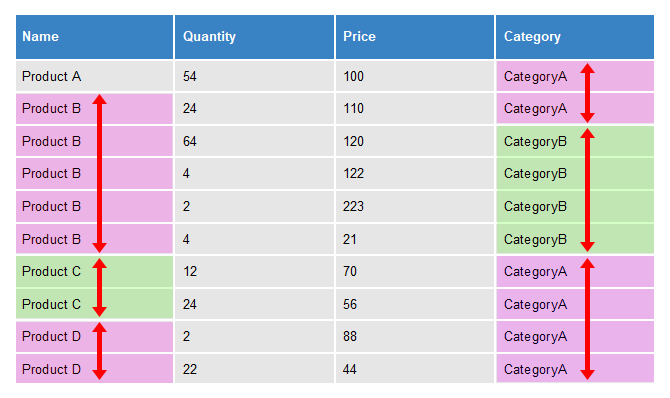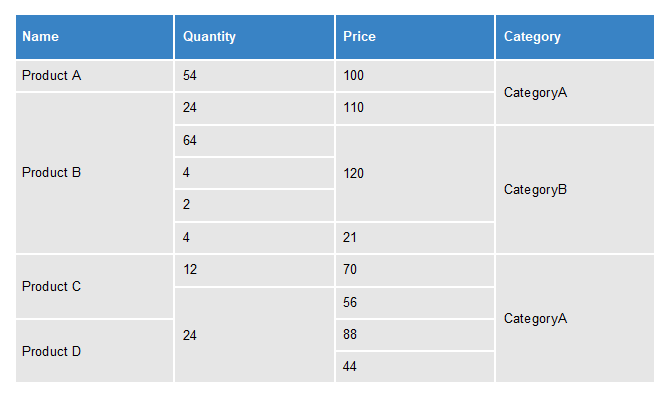Merging Merge Block Cells Vertically with Matching Content
A merge block repeats defined content and merge fields based on given data rows of a specific child table or object. This demo shows how to vertically merge table cells in case the content is the same.

Merge blocks repeat content and included merge fields based on given data rows of a specific child table or object. Content within this block can be filtered and sorted with build-in functionality of the Mail
Sample Merge Block
Consider the following merge block template:

After merging some data into this block, the MailMerge class produces the following output:

In a post-merge process, the vertically adjacent cells with the same content should be merged as shown in the next illustration:

Mark Merge Block Tables
In a first step, a Block
// merge data
using (TXTextControl.DocumentServer.MailMerge mm =
new TXTextControl.DocumentServer.MailMerge()) {
mm.TextComponent = textControl1;
mm.BlockRowMerged += Mm_BlockRowMerged;
mm.MergeObject(report);
}In that event, the first cell is marked with the Name block_identifier.
private void Mm_BlockRowMerged(
object sender,
TXTextControl.DocumentServer.MailMerge.BlockRowMergedEventArgs e) {
using (TXTextControl.ServerTextControl tx = new TXTextControl.ServerTextControl()) {
tx.Create();
tx.Load(e.MergedBlockRow, TXTextControl.BinaryStreamType.InternalUnicodeFormat);
// find all tables in a block and flag cell 1,1
if (tx.Tables.GetItem() != null) {
tx.Tables.GetItem().Cells.GetItem(1, 1).Name = "block_identifier";
}
byte[] data;
tx.Save(out data, TXTextControl.BinaryStreamType.InternalUnicodeFormat);
e.MergedBlockRow = data;
}
}After the Merge
// loop through all tables, find flagged block tables
// and pass them to "MergeSimilarColumns"
foreach (TXTextControl.Table table in FindBlockTables(textControl1)) {
MergeSimilarColumns(table);
}Comparing the Cells
The actual work is done in the MergeSimilarCells method that loops through all columns separately to find similar vertically adjacent cells with the same content. If cells are found with the same content, they are vertically merged and the cell's text is replaced with the common content.
private bool MergeSimilarCells(TXTextControl.Table table, bool firstIteration = true) {
// loop through all column separately
foreach (TXTextControl.TableColumn col in table.Columns) {
bool bMergeFlag = false;
int iFirstRow = 0;
string sCommonCellText = "";
// row by row
for (int row = 1; row <= table.Rows.Count; row++) {
// only cells that are not merged
if (table.Cells[row, col.Column].Length != -1) {
// if table cell contains text from previous cell
// set "bMergeFlag" to true and flag row number
if (table.Cells[row, col.Column].Text == sCommonCellText) {
if (bMergeFlag == false) iFirstRow = row;
bMergeFlag = true;
}
// if text is different and "bMergeFlag" is true, merge cells
else if (bMergeFlag == true) {
MergeCells(table, iFirstRow - 1, col.Column, row - 1, col.Column, sCommonCellText);
bMergeFlag = false;
}
// if flag "bMergeFlag" is true and it is the last row, merge cells
if (bMergeFlag == true &&
row == table.Rows.Count &&
table.Cells[row, col.Column].Text == sCommonCellText) {
MergeCells(table, iFirstRow - 1, col.Column, row, col.Column, sCommonCellText);
}
// remember current cell text
if (row < table.Rows.Count)
sCommonCellText = table.Cells[row, col.Column].Text;
}
}
}
// two iterations required as rows are potentially merged
if (firstIteration == true)
MergeSimilarCells(table, false);
return false;
}
// this method simply merges given cells and sets the common cell text
private void MergeCells(
TXTextControl.Table table,
int startRow,
int startColumn,
int stopRow,
int stopColumn,
string newText) {
table.Select(startRow, startColumn, stopRow, stopColumn);
table.MergeCells();
table.Cells[startRow, startColumn].Text = newText;
}This method must loop through the table twice (the function calls itself at the end) as complete rows are potentially merged which could result in more adjacent cells with the same content.

If the data is changed, so that cells in the columns Quantity and Price match, results look similar to the table shown in the next screenshot:

The vertical text alignment can be changed in the template, so that the merged table content is rendered in the middle of the table cell to generate a more readable layout:

Sample Project
This sample shows the flexibility of the MailMerge functionality. At any point, it is possible to interact during the merge process using the events or it is possible to manipulate the document after the merge process is finished.
Test this on your own by looking at the sample that is hosted in our GitHub account. This demo uses the Windows Forms version, but the code works with WPF and ASP.NET as well.
![]()
Download and Fork This Sample on GitHub
We proudly host our sample code on github.com/TextControl.
Please fork and contribute.
Requirements for this sample
- Visual Studio 2019
- TX Text Control .NET for Windows Forms (trial sufficient)
ASP.NET
Integrate document processing into your applications to create documents such as PDFs and MS Word documents, including client-side document editing, viewing, and electronic signatures.
- Angular
- Blazor
- React
- JavaScript
- ASP.NET MVC, ASP.NET Core, and WebForms
Related Posts
ASP.NETWindows FormsMail Merge
Table Extension: Remove Empty Columns After Mail Merge
When you use mail merge to merge repeating blocks, you may end up with blank columns if no data exists for a particular column. Removing empty columns from a table is demonstrated in this example.
ASP.NETWindows FormsASP.NET Core
Splitting Tables at Bookmark Positions and Cloning Table Headers
This article shows how to split tables at bookmark positions and how to clone table headers in TX Text Control .NET for Windows Forms and TX Text Control .NET Server.
Loading and Processing Excel XLSX Spreadsheet Tables into TX Text Control…
TX Text Control provides a powerful API to load and process Excel spreadsheet tables in .NET applications. This article shows how to load an Excel file and process the tables using TX Text Control…
Text to Table and Table to Text in TX Text Control and C#
TX Text Control provides powerful table features and also full access to text formatting which can be used to create tables from text and vice versa. This article shows how to convert text to…
Inserting MergeBlocks with the DataSourceManager and Applying Table Styles in C#
This article shows how to insert MergeBlocks with the DataSourceManager and how to apply table styles to those tables. The article uses the DocumentServer class to insert MergeBlocks with the…






